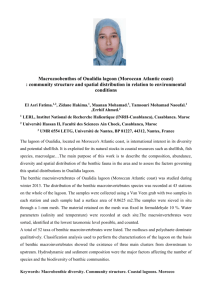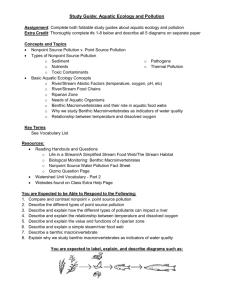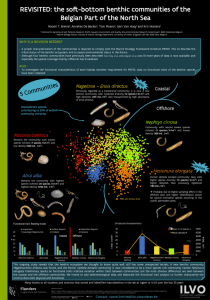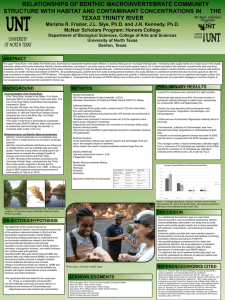Sampling Method Marine benthic macroinvertebrate communities
advertisement
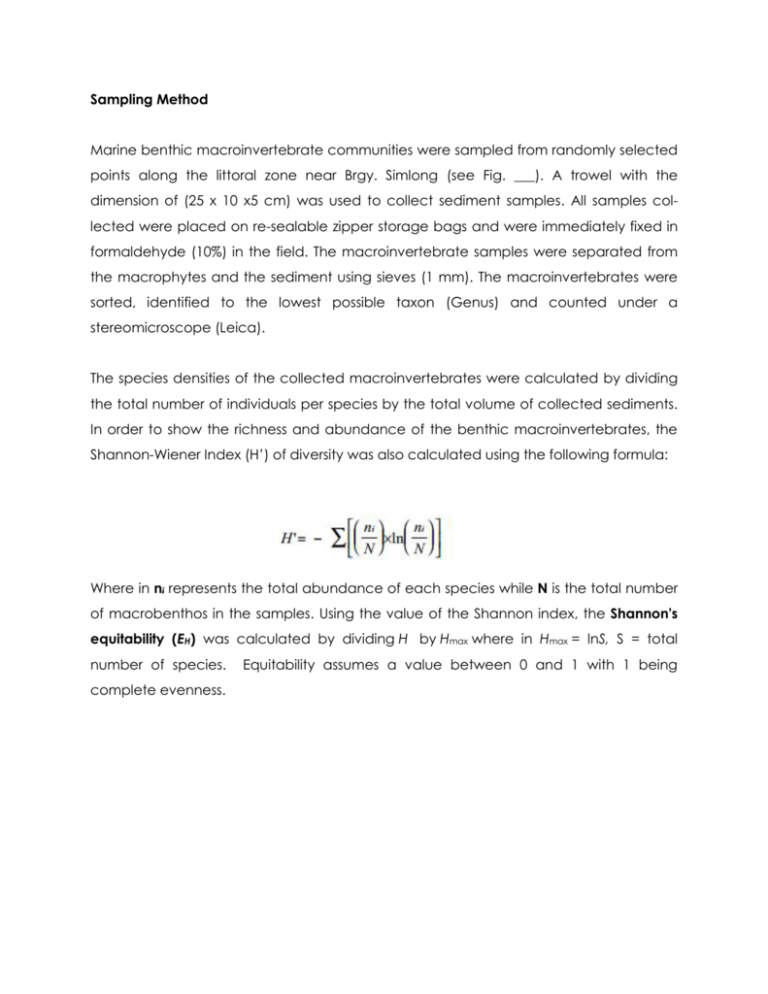
Sampling Method Marine benthic macroinvertebrate communities were sampled from randomly selected points along the littoral zone near Brgy. Simlong (see Fig. ___). A trowel with the dimension of (25 x 10 x5 cm) was used to collect sediment samples. All samples collected were placed on re-sealable zipper storage bags and were immediately fixed in formaldehyde (10%) in the field. The macroinvertebrate samples were separated from the macrophytes and the sediment using sieves (1 mm). The macroinvertebrates were sorted, identified to the lowest possible taxon (Genus) and counted under a stereomicroscope (Leica). The species densities of the collected macroinvertebrates were calculated by dividing the total number of individuals per species by the total volume of collected sediments. In order to show the richness and abundance of the benthic macroinvertebrates, the Shannon-Wiener Index (H’) of diversity was also calculated using the following formula: Where in ni represents the total abundance of each species while N is the total number of macrobenthos in the samples. Using the value of the Shannon index, the Shannon's equitability (EH) was calculated by dividing H by Hmax where in Hmax = lnS, S = total number of species. complete evenness. Equitability assumes a value between 0 and 1 with 1 being Results and Discussion Table 1. Relative abundances of the macrobenthic community in Simlong, Bantangas. Taxon Mollusca Oliva sp. Melanoides sp. Gyrineum sp. Collubella sp. Atys sp. Turbo sp. Donax sp. Iphigenia sp. Plebidonax Ostrea sp. Echinodermata Diadema sp. Foraminefera foramineferans Total Density ( m ) Relative Abundance 600 2000 1200 800 200 400 800 800 1200 1000 0.08 0.28 0.17 0.11 0.03 0.06 0.11 0.11 0.17 0.14 400 0.06 713200 722600 98.70 100 3 Table 1. Shows list the different genera of the benthic macroinvertebrates that were collected and their respective densities and relative abundance. From the obtained results, it was observed that the macro benthic community of Brgy. Simlong is composed of species belonging to Phylum Mollusca, Echinodermata, and Foraminifera. A community demonstrates a high diversity if many equally abundant species are present. A total of twelve genera were identified in the sediments samples. Foraminifera species were the most abundant with a total density of 713,200 per m3. In a particular community that possess high species richness may indicate that there is a high level of energy transfer. However, it is highly noticeable that in the samples, there were relatively few genera were identified were there are certain species that dominates the system. The dominance of this species may disrupt the equal energy distribution for the organism that is present in the system. Table 2. Diversity analyses of macrobenthos in Brgy. Simlong Genus Oliva sp. Melanoides sp. Gyrineum sp. Collubella sp. Atys sp. Turbo sp. Donax sp. Iphigenia sp. Plebidonax Ostrea sp. Diadema sp. foramineferans Total Total no. of individuals 3 10 6 4 1 2 4 4 6 5 2 3566 LN(Pi) Pi*LN(Pi) -7.094 -0.0059 -5.890 -0.0163 -6.401 -0.0106 -6.806 -0.0075 -8.192 -0.0023 -7.499 -0.0042 -6.806 -0.0075 -6.806 -0.0075 -6.401 -0.0106 -6.583 -0.0091 -7.499 -0.0042 -0.013 -0.0129 3613 -0.0987 H'= 0.0987 EH = 0.039703 Based on the collected data, Brgy Simlong has a diversity Index of H’= 0.0987 as shown in table 2. This only means that there is a low community complexity within the sampling area. In terms of evenness index, having EH value of 0.0397 means that the sampling area in barangay Simlong are composed of species that are not equally distributed. Since equitability assumes a value from 0 to 1 with 1 having complete evenness, we can say that the macrobenthic community have a number of species that dominates and makes the system not stable for benthic habitat. It should be noted however that only two sediment samples were collected for this study which may not be enough to explain the complexity of the whole study area. It is suggested that in order to show the real diversity of the benthic macroinvertebrates, more sediments samples should be collected at different random sampling points. The presence and absence of species may reflect the present condition of the system. The low species richness in the system may imply that other organisms specifically macrobenthos struggle to survive with the condition of water. Domestic waste effluents may have change the condition of water thus affecting the benthic organisms. The fact that majority of the organisms collected belongs to phylum Mollusca, a group with relatively high tolerance on changing environment, may possibly reflect the quality of water in the area. However, further studies should be done that involve water quality components in other to have a conclusive explanation on the absence of other macrobenthic species in Brgy. Simlong.
